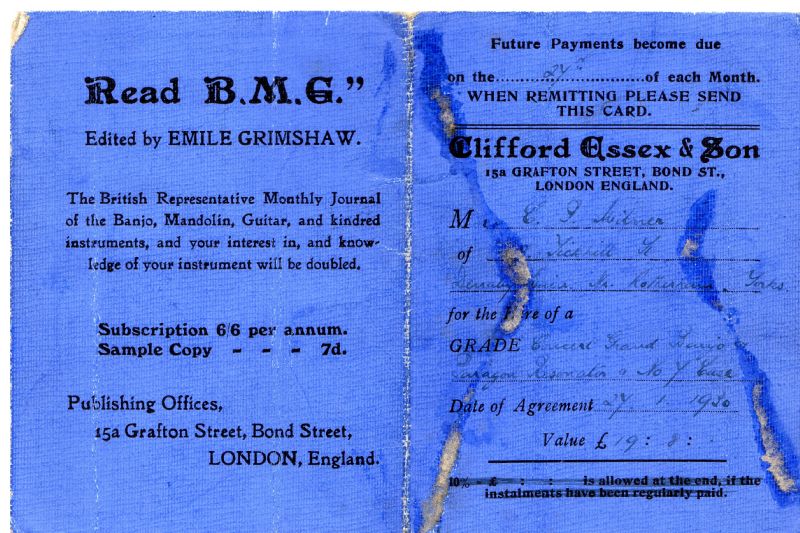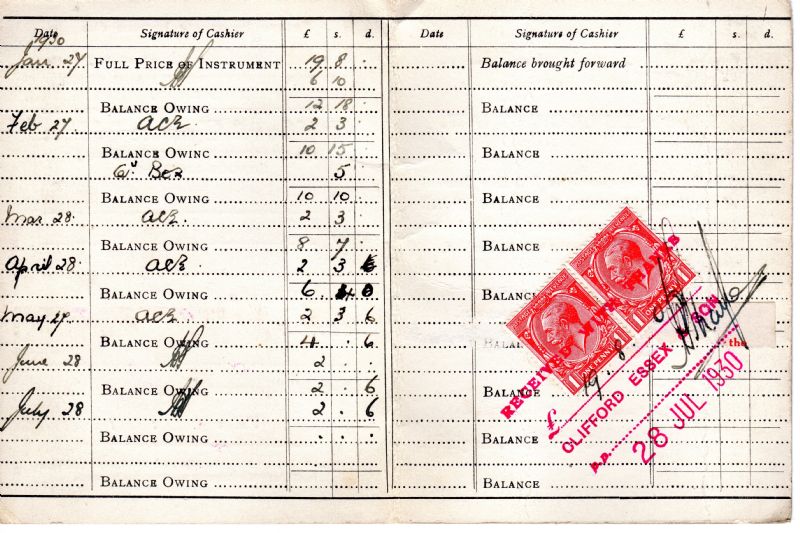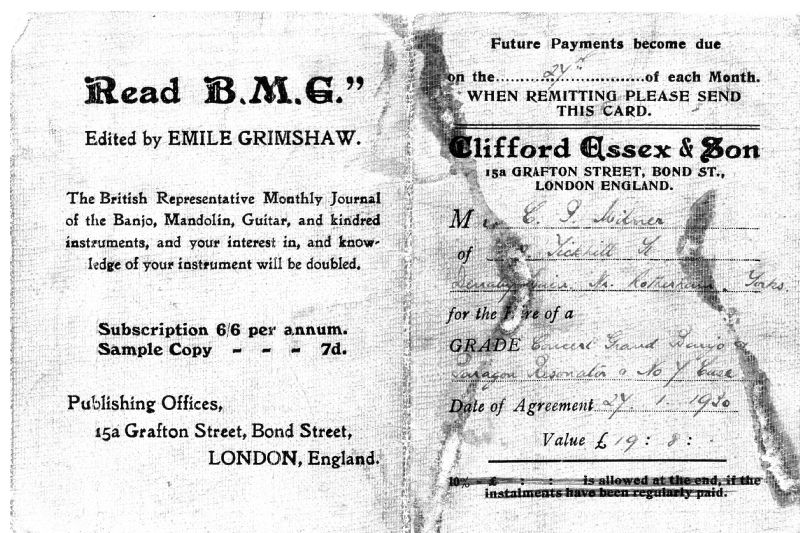Classic-Banjo
A Site Dedicated to all enthusiasts of Classic Style Banjo
Essex catered for the upper classes right from the start when he opened his banjo studio in the former premises of Sir Henry Irving.. The year is 1910.
Replies to This Discussion
-
Permalink Reply by Richard William Ineson on May 15, 2023 at 11:22
-
Permalink Reply by Joel Hooks on May 15, 2023 at 14:55
-
Yes, and in the US the wealthy took up the banjo too (with manufacturers willing to sell them fancy stuff). That said, the large driver of banjo music in the US was the working class. This included many (if not most) of the top pros:
Alfred Farland textile mill worker before banjo
George Lansing clerk in a drugstore
E. M. Hall barber
Vess L. Ossman delivery wagon driver for his family's bakery.
Fred Van Eps watchmaker apprentice
Albert Baur runaway as a teenager, sold insurance and later real estate
William Farmer plumber/pipe fitter
Alex Magee plumber/pipe fitter
Frank Bradbury sold insurance
Fred Stuber father ran a photography studio
Frank Converse runaway as a teenager, father was a music teacher
George Gregory demonstrated instruments at a music store, suspected of embezzling money, went on the run, took his own life when cornered by police.
This list can go on and on.
-
Permalink Reply by Richard William Ineson on May 15, 2023 at 18:05
-
Joel, many of the well known banjo players in the UK also had humble origins, Morley's father was a bricklayer, Sid Turner was a barber, Ernest Jones was a bookmaker, Grimshaw's family were mill workers in Lancashire, Charlie Rogers' father was a butcher, Will Pepper was in the building trade. Clifford Essex' father was described as a 'currier' a dealer/trader/worker in leather, his business was based in Wrexham, Essex knew that he needed to abandon his real origins in what was disdainfully known as 'trade' by the upper classes and invent a more suitable new background for himself if he was to have any success in establishing a studio which would be attractive to his preferred clientele, the Titled and the rich. He claimed to have attended Rugby school and then later, entered the legal profession (he actually became a wine merchant and became bankrupt), He changed his accent to what was described as 'a slow drawl', he can be heard introducing a cylinder recording of Sid Turner where he pronounces B.E.F. (British Expeditionary Force) as 'Bay Ay Aif'. The photo of Mrs. F. Ward shows how successful his subterfuge was, Mrs. Ward would have been horrified to know that her eminent banjo tutor, Mr. Clifford Essex, was the son of a Wrexham fellmonger. Cammeyer also occupied premises with the 'correct' address, Jermyn Street, (his studio was actually in Duke of York Street which is adjacent to Jermyn Street) His background as the son of a Brooklyn grocer was covered by his passport which described him as a 'Gentleman', a person of independent financial means, his foreign Nationality would probably have precluded any 'awkward' questions being asked about his true status in life.
Joel Hooks said:Yes, and in the US the wealthy took up the banjo too (with manufacturers willing to sell them fancy stuff). That said, the large driver of banjo music in the US was the working class. This included many (if not most) of the top pros:
Alfred Farland textile mill worker before banjo
George Lansing clerk in a drugstore
E. M. Hall barber
Vess L. Ossman delivery wagon driver for his family's bakery.
Fred Van Eps watchmaker apprentice
Albert Baur runaway as a teenager, sold insurance and later real estate
William Farmer plumber/pipe fitter
Alex Magee plumber/pipe fitter
Frank Bradbury sold insurance
Fred Stuber father ran a photography studio
Frank Converse runaway as a teenager, father was a music teacher
George Gregory demonstrated instruments at a music store, suspected of embezzling money, went on the run, took his own life when cornered by police.
This list can go on and on.
-
Permalink Reply by Richard William Ineson on May 16, 2023 at 5:31
-
It's an interesting photograph nevertheless, it turned up at an antique market in Swinderby about ten years ago. I wonder who Mrs. F Ward was? She was obviously a woman of means, her banjo would have been beyond the financial reach of 95% of the population at the time.
Mike Bostock said:We must also take care not to assume London-centric patterns were a template for the whole U.K. Nor even that the behaviour of London banjo manufacturers was necessarily representative of London banjoists as a whole.
This goes to the core of the problem of extrapolating banjo ‘history’ from the often self-promotional narratives of a very few individuals who had a disproportionate presence in contemporary banjo literature. For example the early years of the BMG that publication was essentially a vehicle for the promotion of Clifford Essex. Interesting though some of the content, is to read, research simply cannot ignore the nature and bias of sources. Research has a responsibility to look beyond the easily accessible.
-
Permalink Reply by Richard William Ineson on May 16, 2023 at 6:34
-
Mike, at a tangent to the present discussion I know, but do you have any information about Kate Sampey, ( a decent photo would be good). When I did the Morley bio in collaboration with Anthony Peabody, I didn't have any detailed info about Kate or a reliable photograph of her. The information side has now been partially addressed ( I went to the source, Hawton Grange near Newark) but I before I write an account of her banjorial activities to add to the Morley bio I thought I'd ask you if you had anything in your archives?
Mike Bostock said:We must also take care not to assume London-centric patterns were a template for the whole U.K. Nor even that the behaviour of London banjo manufacturers was necessarily representative of London banjoists as a whole.
This goes to the core of the problem of extrapolating banjo ‘history’ from the often self-promotional narratives of a very few individuals who had a disproportionate presence in contemporary banjo literature. For example the early years of the BMG that publication was essentially a vehicle for the promotion of Clifford Essex. Interesting though some of the content, is to read, research simply cannot ignore the nature and bias of sources. Research has a responsibility to look beyond the easily accessible.
-
Permalink Reply by Richard William Ineson on May 16, 2023 at 8:59
-
Thanks Mike, Anthony and I did turn up a few newspaper cuttings relating to KS and her family but no reliable photo, she seems to have been semi prominent on the London stage but didn't leave a real mark. She was certainly a plucky young woman to leave a comfortable home in Hawton in the late 1880s, to play the banjo in London. I wonder who taught her to play the banjo?
Mike Bostock said:Richard, it is lovely photo and a fortunate recovery find from that antique market. Unfortunately I don't have a photograph of Kate Sampey to share. As you know, period photos featuring banjo pop up so randomly. I'm guessing from your reference to places and dates that you have collated all her details from the newspaper archive and census. A quick search this morning brings up quite a few. I just wondered if you have this 'buried' description to her London debut and also a death notice from 1923?
I look forward to reading your revised biography.
-
Permalink Reply by Richard William Ineson on May 16, 2023 at 9:20
-
The Sampeys were 'gentleman' farmers long established in Hawton, they obviously had money and Kate was a beneficiary thereof. Her parents must have been quite forward thinking to allow her to make the London stage and the banjo her profession.
Mike Bostock said:Kate does demonstrate a spirit of independence and determination to follow her talent. The census returns show she was living on her own means. The only year that mentions a musical link is 1891 when her occupation is given 'musician'. So often active banjoists in the Victorian era left no clue to that musical activity in the census. Kate's was a fascinating arc from farmer' daughter to London-based musician. I guess we'll never know whether that was due to encouragement and supportive parents or a reaction against the opposite?
-
Permalink Reply by Richard William Ineson on May 16, 2023 at 10:49
-
It's certainly food for thought, and will probably repay further investigation. For Mrs. Ward to have such an expensive banjo made available to her at the very start of her studies, combined with R.Tarrant Bailey being her teacher, which wouldn't have been cheap, then for her to examined for her 'A' grade diploma by Clifford Essex himself, which must have involved travelling and accommodation costs, certainly points to the Wards being persons of substance.
Mike Bostock said:'Mrs F Ward'.
My own research area is almost exclusively pre-1885 but local interest (I live in North Somerset) and frankly curiosity means that I couldn't resist...
The 1911 Census has a single reference to an 'F' Ward female aged between 20-40 living in Bath. That individual (Florence Ward) is recorded as single which rules her out. So applying the then common social convention that the initial in the title 'Mrs F Ward' was her husband's initial brings up two candidates. Lily Annie Ward aged 35 was the wife of Frederick William Ward, 41, whose occupation was 'musician (orchestral)'. A musical household looks the likely source for ID of the person in your photo. To be transparent the other entry is Amelia Ward aged 37, wife of Frederick James Ward, 40, engine driver. No reason why an engine driver's wife wouldn't play the banjo. But the musical link with the husband does seem a strong pointer.
What is interesting from a social history perspective is that both Lily Annie Ward and Amelia Ward were living in the Twerton district of Bath. Twerton was/is an industrial area of Victorian closely-built streets of predominantly terraced housing near the railway line built to house Bath's working class population and quite off the genteel Georgian map. I lived in Bath as a student. Even today it is a town characterised by a noticeable 'town and gown' division. In the Victorian and Edwardian period this division would have functioned in effect as a virtual 'social apartheid'. Parlor maids, servants and functionaries for the wealthier residents, but ne'eer the twain do meet in a social context. We can see from this example that rising wages meant that hardworking, 'respectable' working class Edwardian households with children could aspire to and afford the luxury of a top end banjo. Whether that purchase was a priority or not is based on other factors.
Go Lily Annie!
-
Permalink Reply by Joel Hooks on May 16, 2023 at 13:11
-
I'm working class and I own three CE banjos including a Concert Grand. I also have some nice outfits that I could have my photo taken in.
-
Permalink Reply by Joel Hooks on May 18, 2023 at 12:43
-
The dress/outfits used in these period banjo photographs have often confused Folk Revival era folklorists as the presumption was that well fitting evening wear, suits, or dresses means wealthy.
One factor that if often overlooked is that expenses were different then compared to now. Unless you live in one of a few major cities in the US you need a car. Cars come with payments or maintenance costs+ monthly insurance and fuel. That becomes a large chunk of change. Pretty much everyone carries a small computer in their pocket (at all economic levels) that is also not cheap and comes with monthly expenses.
While people did not have a lot of money, many working class young persons had some money to spend. So they bought banjos, bicycles, nice outfits, etc..
Also I offer the following regarding CE banjos:
This payment book came with my Concert Grand. Notice that it was just after the US market crash.
CE was offering credit to get banjos in the hands of people who could not otherwise afford them. Why would they need to do this if all of their customers were slinging cash?
-
Permalink Reply by Joel Hooks on May 20, 2023 at 16:34
-
Permalink Reply by Richard William Ineson on July 4, 2023 at 16:17
-
Mike I found the photo of Edward V11's fretless banjo which I think I mentioned previously. It's in the October, 1930 B.M.G. magazine, there is a short article about it, the banjo was made in 1864, it's a poor photo but you may be able to identify the maker.
Mike Bostock said:…there are also references to more socially ‘elevated’ English banjo players in the early period. Aspects of some early English banjos also suggest a middle class clientele. The picture is quite complex and resists a simple reductive theory in regard to interest in the banjo. What we do see evidence of in the early period, as with many new introductions, is a youthful interest. Age to some extent mitigating or overriding the effect of social and financial circumstance.
© 2025 Created by thereallyniceman.
Powered by
![]()


